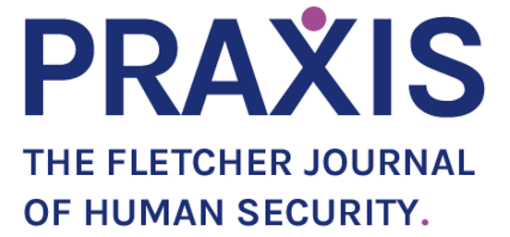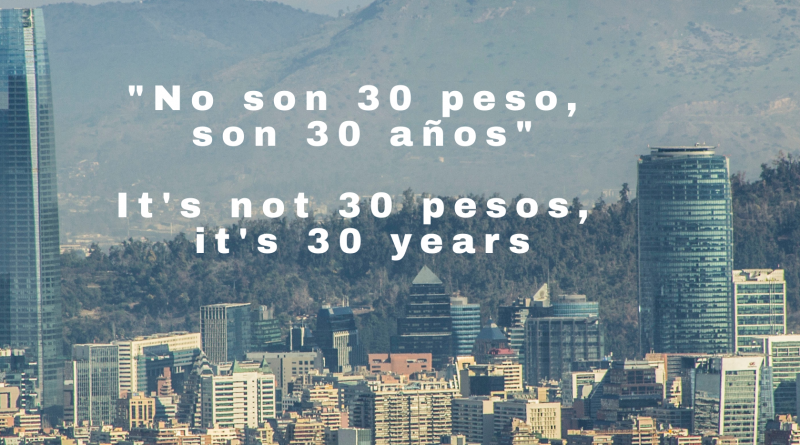The 2019-2020 Chilean Protests
The 2019-2020 Chilean Protests
by Juan Ignacio Chacón
This article is a translation from the original in Spanish.
A Chronicle From the Uncertainty
Part I: Timeline of Events and Origins of the Protests
Chile recently experienced the largest earthquake in the country’s recorded history, yet the ground trembling that would terrify most people doesn’t even distract Chileans from their coffees. Because earthquakes are so common in the country, Chileans have come to view these natural phenomena as normal occurrences of daily life.
However, since October 18, 2019, a different kind of turbulence has shaken the country. Some call it a revolution, a movement that has elicited symbols of guillotines and rolling heads. Chile’s government has come to be seen as an entrenched elite, sequestered in its version of Versailles, and large masses of people are taking to the streets throughout Santiago and across the country to protest it.
In October, the Chilean government announced an increase in public transit fares (by a relatively small amount) that set off a social uproar. Students began protesting the week before by simply refusing to pay fares for the metro, jumping turnstiles, and entering subway cars en masse. However, on October 18, the protests became widespread and increased in intensity. After a couple of hours, they turned violent as well – twenty metro stations were burned, and forty more were damaged.
Millions of people demonstrated peacefully in the street, but a small minority took advantage of the chaotic situation and looted and torched infrastructure. Over the course of a couple of hours, traffic lights and traffic signals were brought down, toll booths and buildings were set on fire and barricades were built. The Piñera government took measures it had not taken since the Pinochet dictatorship: it declared a state of emergency[1] and deployed the military, stating, “we are at war.” This was the same government whose officials had told the international press only a few days prior that Chile, compared to its Latin American neighbors, was “an oasis of stability.” Evidently this war declaration did nothing but inflame the population’s feelings of injustice and multiplied the number of people taking the streets to make their voices heard. They painted graffiti across almost every wall and monument expressing a clear and powerful demand: the resignation of President Sebastián Piñera.
Chile’s police internalized the President’s “call to war” and authorities began viciously repressing the protests by carrying out violence against both peaceful and violent demonstrators. The police brutality was appalling, with officers beating, torturing, even blinding participants (from pellets shot at the faces of protesters). This shows, on one hand, how the police were poorly trained to act with restraint, and on the other hand, the government’s empty commitment to protect human rights and preserve democratic principles more generally.
At the time of writing, these violent acts had not been condemned by the government and instead were directly endorsed by the head of the police—who emphatically declared that he would not allow anyone to be criminally charged. Nevertheless, the widespread abuse was brought to the attention of the Inter-American Commission on Human Rights, who sent a team of observers to Chile to investigate the situation. Their conclusion, which didn’t take long to reach, was overwhelming: in Chile, human rights, including the right to life (violent deaths), physical and psychological integrity (ill-treatment, torture, sexual violence, mutilations and other degrading treatment), due process (illegal detentions), the right to assembly and others, have been violated with impunity.
The Commission wasn´t alone in its claims about human rights abuses. In the course of a few weeks, teams of observers from Amnesty International, Human Rights Watch and the Office of the UN High Commissioner for Human Rights visited Chile. Each of them reached similar conclusions, with parallel justifications: human rights were being violated in a “general and systematized” manner.
“It isn’t thirty pesos… it’s thirty years.” This is one of the popular protest slogans that depicts how anger about the thirty-peso increase of the metro fare is a symbol of the simmering discontent that had long gone unvoiced. The phrase represents widely held grievances about inequality that the Chilean population has endured and tolerated for over thirty years.
Let’s consider the underlying causes of this discontent and even anger. The first cause functions as a basis for the others: it relates to a neoliberal economic model that was strictly imposed in Chile starting in 1973 under Pinochet. This model was created by American economist Milton Friedman and was conceived of as a prototype, though Friedman was bold enough to propose that it be implemented as a controlled economic experiment. This model entailed deregulating markets, promoting free trade and diminishing state welfare provisions. Since Chile’s dictatorship prohibited deliberation or opposition by the public, Friedman’s “experiment” immediately reduced the welfare State[2] and led to the gradual dissolution of social bonds and a weakening of communities in favor of the “individual.”
This neoliberal experiment resulted in extractive development that gradually exhausted Chile’s natural resources and devastated agriculture, livestock and forest sectors. The model, as was intended, created large benefits for only an extremely small portion of Chilean society. It also led to the current inadequacies in the healthcare and pension systems that entrench poverty. In Chile, if you are sick and don’t have expensive private insurance, your chances of recovering are, to use the word without irony, very poor.
The education system in Chile is a particularly grave casualty of this economic model. Even before 1980, Chile experienced the disappearance of the State as the stable provider of free, quality public education in favor of “vouchers” held by private and semi-private schools. Naturally, this private-leaning educational system, also insufficiently regulated, does not have the capacity to ensure that Chilean schools meet acceptable standards of education for a country categorized as “middle income.“ The privatization of higher education over the last thirty years has caused an “eliticization” of quality education. Therefore, if your family has enough money (or contacts) to send you to private schools, your entrance into a good university and a lucrative career is also likely assured.
Furthermore, Congress who ought to serve the needs and desires of the majority of citizens, appears to have been gradually co-opted by economic elite in the country. For example, Julio Ponce Lerou, a businessman who has made millions of dollars since the seventies due to favorable privatization conditions, has donated money and gifts to a wide array of politicians over the past few decades. He does this in exchange for laws (dictated almost verbatim from his office) that perpetuate privileges to the wealthiest while exacerbating existing inequality and hardship for so many Chileans. With armed forces and police submerged in corruption scandals, high prices similar to those of Germany, third world services, and a general feeling that almost everything is operating through powerful manipulation and with de facto impunity, it was a question of “when” rather than “if” Chile would be pushed to the brink of political explosion.
Part II: Current State of Affairs and Looking Forward
Almost four months have passed since protests erupted. Visiting the center of Santiago and Plaza Italia (the epicenter of the demonstrations, poetically renamed the “Plaza of Dignity”) is like visiting a kind of ground zero. Here one finds the space barren of commerce, store windows buried behind layers of graffiti with illustrations calling out the ineptitude of the elite governing class and widespread police violence.
It is clear that the breed of free-market neoliberalism brought to Chile by Milton Friedman in the 1970s generated certain wealth within the country. The establishment of democracy after the end of the dictatorship, combined with the rise of political coalitions with social democratic leanings, produced a certain stability in Chile that positioned it to become an example of positive progress in the region. The political coalitions were successful in achieving economic growth unprecedented in Chile’s history, reducing poverty, revitalizing the economy and allowing for degrees of social inclusion that did limit the extent of the more negative effects of neoliberalism.
Democratic government showed the world “good” macroeconomic figures that situated the country on the brink of development, far above those that any other Latin American country exhibited. However, the Chilean democracy just “managed the model,” injecting little doses of welfare policies here and there instead of making attempts to truly probe the model or change it. The adjustments to the economic model were always merely “cosmetic” and didn´t address core structural issues. For three decades it seemed like the idea worked, despite the fact that by 2006, signs of unrest were growing. In 2006, the first student revolution, led by secondary school students, protested the poor quality of education and already perceptible economic inequality. Protesters continue to be frustrated with education, healthcare, pensions, excessive prioritization of Santiago over the other provinces, and indiscriminate exploitation of resources and the environment.
Despite the many warning signs of this increasing disillusionment, these somewhat silent fault lines were never taken seriously until the October 18, 2019, when the situation exploded. Historic slogans like those from 1980s protest songs resurfaced with resounding force —“join the dance of those who are left behind.” “Chile awoke!” is heard throughout the streets. It is clear that the same temporary policy band-aids cannot be prescribed to cure the country’s serious disease, treatments that ended up transforming Chile from sick to apoplectic to then something as delirious as Don Quixote of La Mancha.
The scenario in the country changes by day-by-day, and remedies employed yesterday to quell discontent and reduce anxieties no longer work. The government, after their initial apathetic reaction, responded to the protests with their automatic reflex to repress. This did nothing more than “fuel the fire” and encourage protesters to continue demonstrating. Cornered, the government backed down near the end of October 2019 and announced a package of social reforms – including pension improvements via state contributions and universal health insurance for those without private health coverage. However, these hastily prepared policies did not cause much relief.
Faced with a social revolution, it was Congress’ turn to act. For decades, Congress has limited participation of the people and is perceived as only favoring the economic and social elites. But now, since one of the most audible protest critiques is about the illegitimacy of a constitution written and enacted under Pinochet´s dictatorship, the people’s representatives felt obliged to act. As never before, all political parties were able to agree, in record time, that it would be in the best interest of Chile to vote both on whether a new constitution should be composed from scratch and on what mechanism should be assembled to outline such a constitution.[3] Later, the country would vote to ratify, or not to ratify, the proposal.
The agreement Congress reached is nuanced, and even though it has symbolic significance, it does not appear to be sufficient to calm the anger. The streets, with or without the new Constitution, are still active and don’t show signs of quieting down. The hunger of the demonstrators seems to have provoked appetites for grand political transformation, but not that which comes from a highly discredited political establishment who continue to push for only incremental change. It seems that whatever deal that could be reached, must necessarily come from “the bottom,” from the people marching in the streets.
In this scenario, the political knot is very difficult to untangle: there are many strands, and at this point it is difficult to figure out how to start again. Chile is in flux, with a paralyzed government in an impasse with protesters. Most of the time, protesters refuse to partake in dialogue (due to a regrettable “all or nothing” mentality) with a Congress who, although united briefly, has begun to fracture again. Along with the globally publicized reports on the human rights situation, the news of the protests tainted the narrative of Chilean exceptionalism, a country which saw itself as gradually moving away from the historic evils that afflicted Latin America.
Furthermore, because of the reports on human rights abuses and damage to Chile’s image internationally, there is a possibility that international judicial proceedings will bring Chile to trial or hold certain individuals criminally liable for “serious, continuous, repeated and widespread” violations of human rights during the crisis. Unfortunately at this time the violence remains. There are no indications that protesters, who nevertheless have mostly demonstrated peacefully, are going to stop. They are more organized (having devised a division by “lines” of which the “front line” acts as a barrier against the police and the following are responsible for protecting the protesters and removing the wounded). In short, no matter how bloody the repression becomes, they show no signs of exhaustion. In spite of the graphic depictions of human rights violations in the findings of the reports, the police have continued their aggression and the government has not shown the necessary ability control its police force. These lack of restrictions, together with the perseverance and nonconformity of the protesters, has kept the situation in an almost feverish state, and it is not yet clear that constitutional reforms or even a new constitution can a lower the temperature.
A lot of pressure will be placed on the April 2020 constitutional referendum to solve current grievances, and there is much at stake. Will there be a new constitution (if this is what most Chileans want)? Will this signify the establishment of new political basis from which the country is redefined? Is a new constitution a powerful enough remedy by itself, without a change of leadership or regime? And above all, will calm return? No one knows for certain what will happen next, but everyone knows that Chile will not go back to the status quo. Although this article was written in the midst of all these uncertainties, there is one clear certitude: Chile has woken up and won’t go back to sleep.
[1] A state of emergency is a measure established in the Chilean Constitution that permits the President, for a “grave breach of public order or for grave danger to the Nation’s security, “to delegate part of their faculties to a higher military command (implying that these militaries perform public order tasks) and to restrict the rights of freedom of movement and assembly (principally through enforcing a curfew).”
[2] The current, but heavily criticized, Constitution of 1980, which is the legal support for the model, defined the state as the “subsidiary” of private activities.
[3] Under the “Mixed Constitutional Convention”, a congregation of 50% of Members of Parliament and 50% of elected representatives, or under the Constituent Convention, in which all the representatives are elected directly.

Juan Ignacio Chacón is a Chilean lawyer with degrees from Universidad de Chile and a LLM from Pennsylvania State University. Juan Ignacio teaches public international law, international human rights law, and legal argumentation at Universidad de Santiago de Chile. Throughout his career he has worked as legal counsellor for the Ministry of Education of Chile, and the National Council of Education. He has also served as a consultant for the Organization of American States and the Inter- American Development Bank in Washington DC. His research has focused on international forced migration and the lack of suitable regulation to address it.

